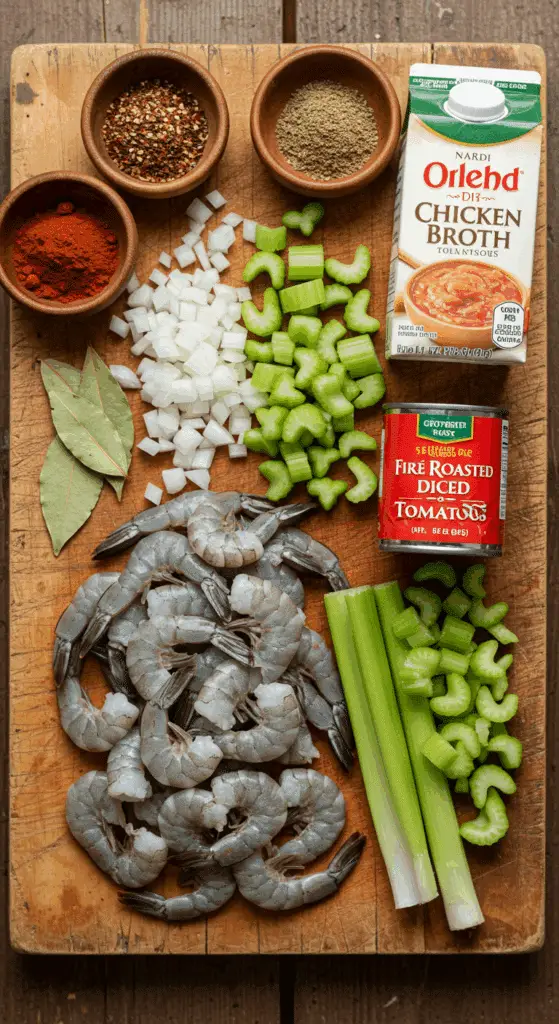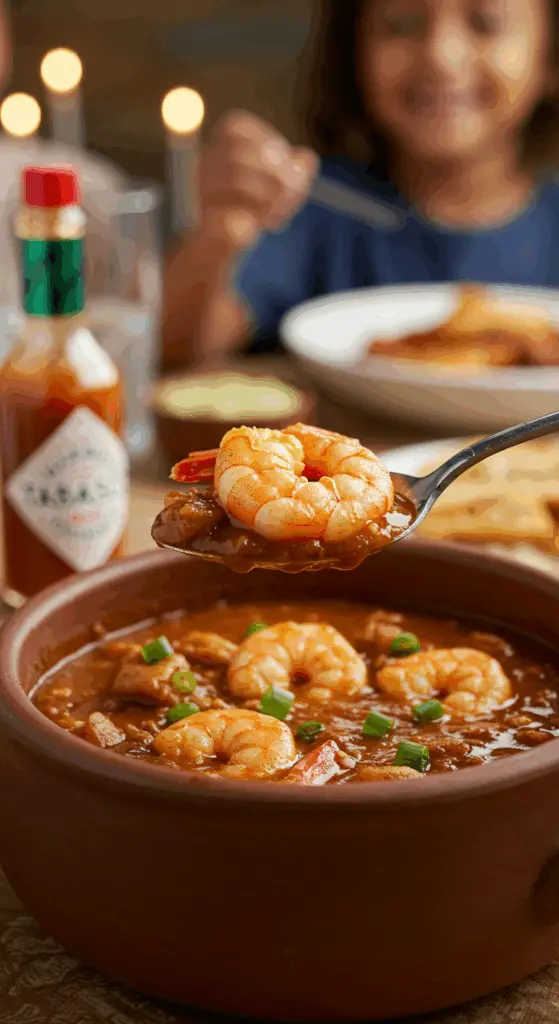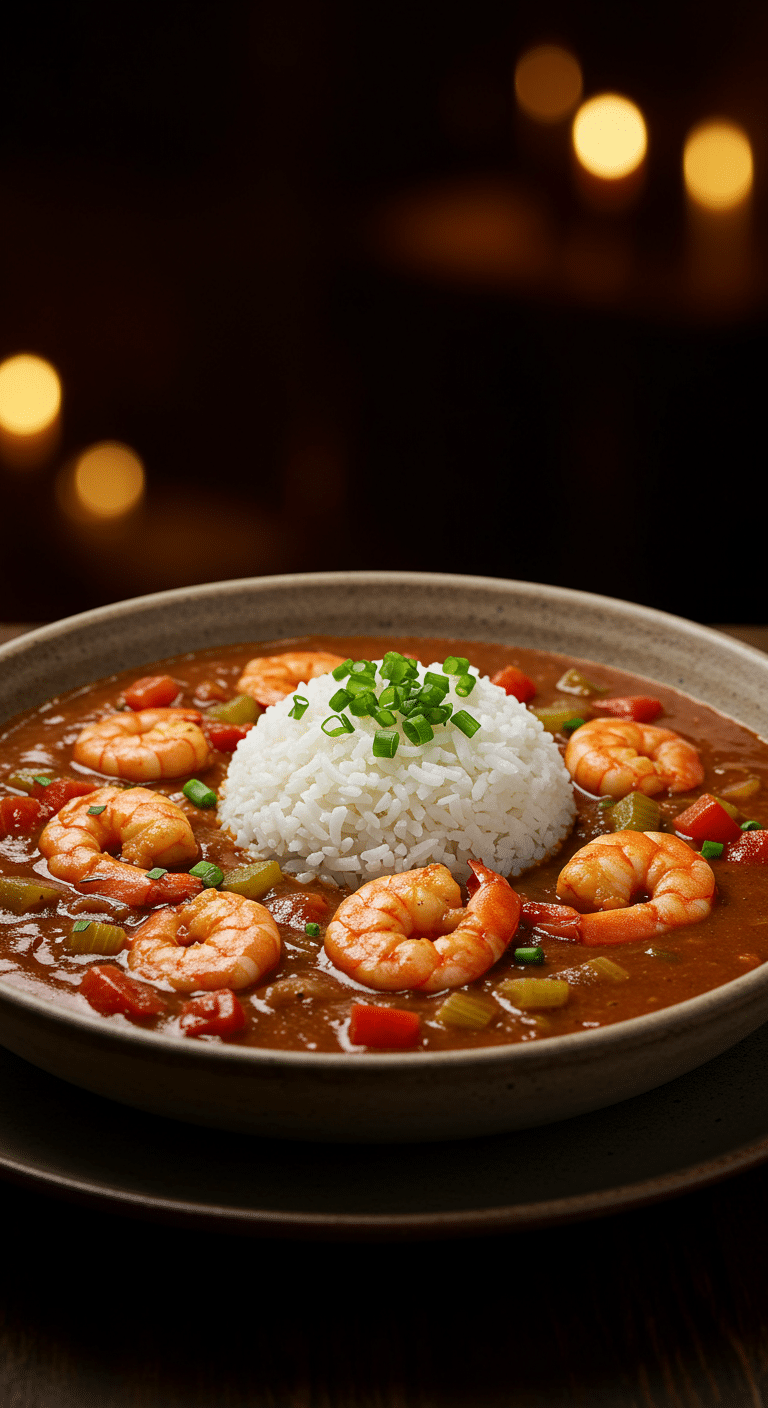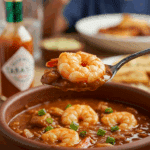Are you ready to transport your kitchen to the heart of New Orleans and create a bowl of the most soulful, satisfying, and unbelievably delicious comfort food imaginable? This incredible, from-scratch Shrimp Gumbo is your ultimate guide to mastering the iconic Louisiana classic at home. We’re talking a rich, dark, and deeply savory broth, packed with the “holy trinity” of vegetables, plump and juicy shrimp, and a modern, healthy twist with kale and quinoa.
This isn’t just another soup recipe; it’s a guide to one of the most beloved dishes in American cuisine. While a true gumbo can seem intimidating, we’ll show you the simple but crucial secrets to the heart and soul of any great gumbo: a perfect, dark roux. This is a show-stopping, one-pot meal that is perfect for a cozy weekend dinner or for impressing guests.
Table of Contents
Table of Contents
Recipe Overview: The Ultimate Louisiana Comfort Food
What makes this Shrimp Gumbo so spectacularly delicious is its incredible, deep, and complex flavor, which is built from a few simple but essential techniques. This recipe is a masterpiece of rustic, Creole-style cooking. The foundation of the entire dish is a dark, nutty roux—a mixture of flour and oil that is slowly cooked until it develops a deep, toasted flavor and a beautiful, dark caramel color. This is combined with the “holy trinity” of Cajun cooking (onion, bell pepper, and celery) to build a savory base. The gumbo is then simmered with a rich broth, classic spices, and finished with tender, plump shrimp and healthy greens.
| Metric | Time / Level |
| Total Time | 1 hour 15 minutes |
| Active Prep Time | 30 minutes |
| Difficulty Level | Intermediate |
| Servings | 4-6 |
The Soul of Gumbo: The Essential Ingredients
This iconic dish uses a handful of high-quality ingredients and one crucial technique to create its signature deep and savory flavor.
- The Roux (The Heart and Soul of Gumbo!):
- This is the single most important component of your gumbo. A roux is a simple mixture of fat and flour that is cooked to thicken the stew and, more importantly, to provide its signature deep, nutty, and toasted flavor. This healthy-ish version uses olive oil and whole wheat flour, but a classic roux is made with all-purpose flour and a neutral oil, butter, or lard.
- The “Holy Trinity”:
- The non-negotiable flavor foundation for any great gumbo is the “holy trinity” of Cajun and Creole cooking: a simple, aromatic blend of chopped onion, green bell pepper, and celery.
- The Seafood & Spices:
- Shrimp: A pound of large, plump shrimp is the sweet and succulent star of the dish. Be sure to use raw, deveined shrimp for the best flavor and texture.
- The Spices: A classic, warm, and perfectly balanced Creole spice blend of smoky paprika, earthy oregano, a touch of chili powder, and a hint of fiery cayenne.
- The Healthy Twists:
- This modern version includes a handful of healthy, chopped kale wilted in at the end and is served with a scoop of wholesome, protein-packed quinoa instead of the traditional white rice.
The Gumbo Masterclass: The Art of the Perfect Dark Roux
Making a dark roux is the most important, and most feared, step in making a gumbo, but it’s surprisingly easy if you follow two simple rules: low heat and constant stirring.
- Be Patient: Making a dark roux is a labor of love. It will take about 20-30 minutes of gentle cooking and stirring to develop that beautiful, deep, nutty flavor and dark caramel or milk chocolate color. Do not rush this process with a high heat, or your flour will burn and your roux will be bitter.
- Stir Constantly: You must stir the roux constantly, preferably with a flat-edged wooden spoon, to ensure you are scraping the bottom of the pot and that the flour is toasting evenly without scorching.
- Be Ready: Have your chopped “holy trinity” vegetables ready to go! As soon as your roux has reached the desired color, you will immediately add the vegetables to the hot pot. This will instantly cool down the roux and stop the cooking process, preventing it from burning.

Step-by-Step to the Best Shrimp Gumbo
This elegant, one-pot meal is a joy to prepare.
Part 1: Make the Roux and Build the Base
Step 1: In a large, heavy-bottomed pot or Dutch oven, whisk together the 3 tablespoons of olive oil and the 3 tablespoons of whole wheat flour over a medium-high heat to create your roux.
Step 2: Continue to cook and mix with a wooden spoon, making sure to scrape the sides and the bottom of the pan, for about 20 minutes, until the roux begins to turn a deep, dark caramel color.
Step 3: Immediately add your chopped onion, green bell peppers, and celery to the hot roux. Sauté the vegetables until the peppers and the onion begin to soften.
Part 2: Simmer and Finish the Dish
Step 1: Add your 1.5 cups of chicken stock, your 1 cup of diced tomatoes, and all your spices (paprika, oregano, chili powder, crushed parsley, crushed bay leaves, and a pinch of cayenne, salt, and pepper). Continue to cook and stir.
Step 2: Once the mixture begins to bubble, lower the heat.
Step 3 (The Final, Quick Step!): Add in your 30 medium shrimp. Continue to cook for about 10 minutes.
Pro Tip: The secret to perfectly tender, not rubbery, shrimp is to add them at the very end of the cooking process. They only need a few minutes in the hot liquid to cook through.
Step 4: Lastly, add in your 1 cup of shredded kale and stir until it has wilted.
Remove the pot from the heat. To serve, top each bowl of the hot gumbo with a scoop of cooked quinoa.

Authentic Shrimp Gumbo (Easy Recipe!)
A healthy and flavorful recipe for a classic Shrimp Gumbo. This dish starts with the essential step of creating a dark roux using olive oil and whole wheat flour. A ‘holy trinity’ of onion and bell peppers is sautéed, and a rich, spicy stew is then built with chicken stock, diced tomatoes, and seasonings like chili powder and paprika. Shrimp are simmered in the gumbo until just cooked through, and fresh kale is wilted in at the very end. The finished gumbo is served over a bed of cooked quinoa for a nutritious twist on the traditional Louisiana favorite.
Ingredients
- 30 medium shrimp, peeled and deveined
- 3 Tbsp olive oil
- 3 Tbsp whole wheat flour
- 1/3 of an onion, chopped
- 2 green bell peppers, chopped
- 1 garlic clove, minced
- 1 Cup diced tomatoes
- 1.5 Cups chicken stock
- 1/2 Tbsp paprika
- 1/2 tsp oregano
- 1 Tbsp chili powder
- 2 Tbsp crushed parsley
- 1 Tbsp crushed bay leaves
- Pinch of cayenne pepper
- Salt and pepper to taste
- 1 Cup shredded kale
- 1 Cup cooked quinoa, for serving
Instructions
- In a large pot or Dutch oven, make the roux by whisking the olive oil and flour together over medium-high heat. Continue stirring constantly with a wooden spoon for about 20 minutes, until the roux begins to turn a dark caramel color.
- Add the chopped onion, bell peppers, and garlic to the roux. Sauté until the vegetables begin to soften.
- Stir in the chicken stock, diced tomatoes, paprika, oregano, chili powder, parsley, crushed bay leaves, and a pinch of cayenne pepper.
- Continue to cook until the mixture begins to bubble.
- Reduce the heat to low and add the shrimp to the pot. Continue cooking for about 10 minutes, until the shrimp are pink and cooked through.
- Finally, stir in the shredded kale and cook just until it has wilted.
- Remove the pot from the heat. Serve the gumbo in bowls, topped with the cooked quinoa.
Notes
- Making a dark roux is the most important and time-consuming step in this recipe; it provides the signature deep, nutty flavor of a good gumbo. It requires constant stirring to prevent it from burning.
- This recipe offers a healthier take on the classic by using whole wheat flour for the roux and serving the gumbo over quinoa instead of white rice.
- The shrimp and kale are added at the very end of the cooking process to ensure they are perfectly cooked and not tough or mushy.
What to Serve With Your Gumbo
A hearty bowl of gumbo is a fantastic, all-in-one meal. To get the full, authentic Louisiana experience, here are a few classic accompaniments:
- Rice: A scoop of simple, fluffy white rice (or the quinoa from the recipe) is the classic and essential base for any gumbo.
- Crusty Bread: A side of warm, crusty French bread is an absolute must-have for sopping up every last drop of that incredible, savory broth.
- A Simple Potato Salad: In many parts of Louisiana, a scoop of a simple, creamy potato salad is served either on the side of, or directly in, the bowl of gumbo!
For more recipe follow my pinterest account
Storage and Make-Ahead Tips
Gumbo is the ultimate make-ahead meal, as the flavors actually become even deeper and more delicious on the second day!
- Make-Ahead: You can prepare the entire gumbo a day or two in advance and store it in the refrigerator.
- Storage: Store any leftover gumbo in an airtight container in the refrigerator for up to 4 days.
- Freezing: This gumbo freezes beautifully! Let it cool completely, then portion it into freezer-safe containers or bags. It will keep in the freezer for up to 3 months.
Frequently Asked Questions (FAQs)
Q1: What is the absolute, number one secret to a truly deep and flavorful gumbo?
The secret is the roux! Taking the time to slowly toast your flour and oil until it has reached a deep, dark, and nutty-smelling stage is the non-negotiable foundation of any great gumbo. It is not just a thickener; it is the primary source of the deep, complex, and savory flavor.
Q2: How do I keep my roux from burning?
The key is low, even heat and constant stirring. Do not walk away from your roux! You must stir it constantly with a flat-edged spoon to ensure that the flour is toasting evenly and is not scorching on the bottom of the pot. If you see any black specks, your roux has burned and you must start over.
Q3: Can I make gumbo ahead of time?
Yes, absolutely! Gumbo is a perfect make-ahead dish. The flavors will actually have even more time to meld and will be even more delicious on the second day. Simply let it cool completely, store it in the refrigerator, and then gently reheat it on the stovetop.
Q4: Can I make this recipe with other kinds of seafood or meat?
Of course! A classic gumbo is wonderfully versatile. You can add or substitute the shrimp with about 1 pound of sliced, smoked andouille sausage (brown it before you make the roux), some flaky crab meat, or even some shredded, cooked chicken.
Q5: What is the “holy trinity” in Cajun cooking?
The “holy trinity” is the classic, aromatic flavor base for a huge number of classic Cajun and Creole dishes. It is a simple but essential combination of finely chopped onion, green bell pepper, and celery.


